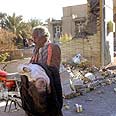
Iran seeking alternate capital in case Tehran destroyed
Country's central legislative council authorizes plan to locate new capital for Islamic Republic that will not be vulnerable to damage from strong earthquakes. Preferred area between Qom and Delijan
Will Tehran soon lose its status as the Iranians adopt a new capital? According to a report in the British newspaper The Guardian, the authorities in Iran are examining the possibility of moving the capital city due to earthquake warnings in Tehran.
After witnessing some of the more tempestuous events in Iran's history, such as the fall of the shah, the return of Ayatollah Khomeini, and the Islamic Revolution, the capital of Tehran is standing before the end of its tenure as a powerful state body approved a plan to look for another capital city. Seismologists have warned that Tehran is vulnerable to large-scale earthquakes in the near future.
The idea was first proposed by Supreme Leader Ayatollah Ali Khamenei and the expediency council rubber-stamped the idea. The expediency council advises the supreme leader and is another tool at his disposal to reign over the country.
At this stage, it is unclear whether the Iranians intend to build a new city from the bottom up or simply to relocate to an existing city. Throughout history, Iran had a number of capital cities, including Isfahan, Qazvin, Shiraz, Mashhad and Hamedan. Tehran has been the nation's top city since 1795 when Qajar king Agha Mohammad Khan declared it his capital.
Infrastructure in the city was strained throughout the 20th century following a sharp rise in its number of residents from 250,000 at the beginning of the century to some 12 million today. In the time of the shah, masses flooded the city from the villages, leading to social discontent that bubbled over during the Islamic Revolution in 1979.
Alongside the rapid increase in population, unregulated development created a city plagued by serious air pollution caused by the numerous vehicles jamming the city's streets.
'Buildings won't survive a quake'
Recently, Tehran was at the center of anti-regime protests following the contested presidential elections in June that saw Mahmoud Ahmadinejad re-elected to another term in office. Opponents have said that he obtained the vote through fraud.
Plans for a new capital were already prepared some 20 years ago, but officials only took them seriously after the 2003 earthquake that destroyed the southwest city of Bam and claimed the lives of 40,000 people. Experts warn that Tehran sits on more than 100 fault lines, one of them about 100 km (60 miles) long, and that many of the buildings in the city would not survive a quake.
Professor Bahram Akasheh, a seismologist and dean of the faculty of basic sciences at Tehran Azad University, said that Tehran was chosen as the capital "by mistake" and that the northeast suburbs are at risk of an earthquake measuring eight on the Richter scale.
"I warned of this 40 to 50 years ago and if they had listened to me then, Tehran wouldn't have grown into a macro-city, but now control is lost over it. The city is growing bigger and bigger every day and so are the poor suburbs around it," he told the Guardian.
Bahram added that the new capital should be located between Qom, the seat of the country's senior religious clerics, and Delijan, an area in the center of the country that has not experienced an earthquake in the last 2,000 years.










